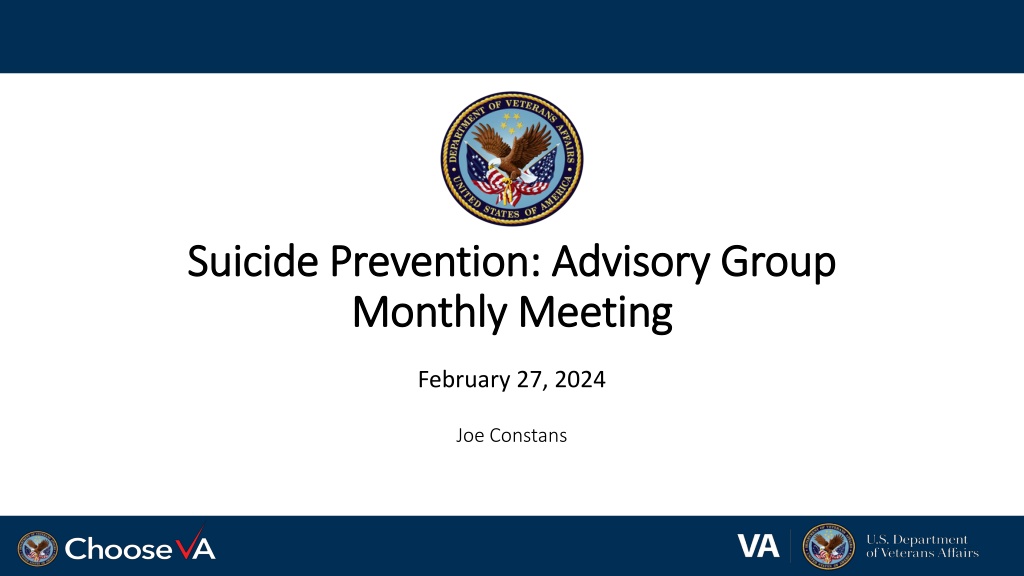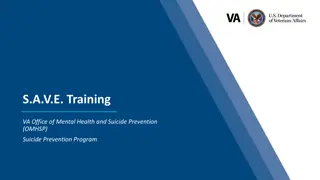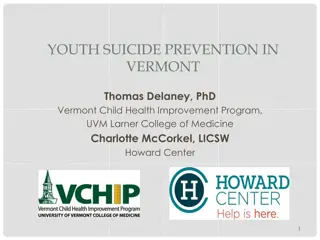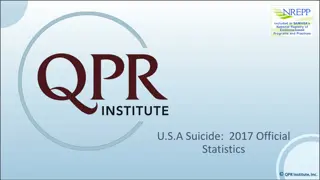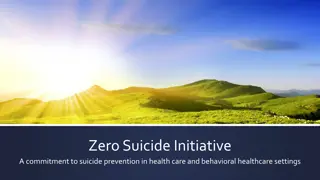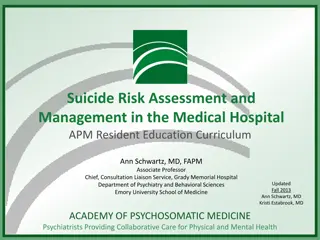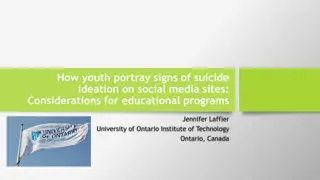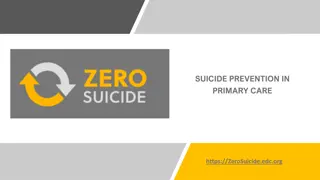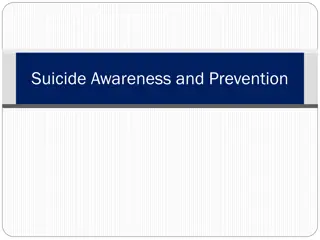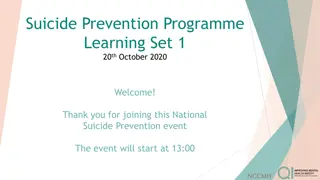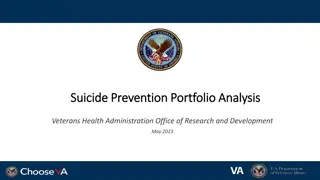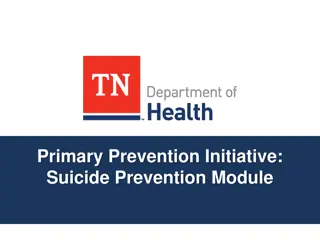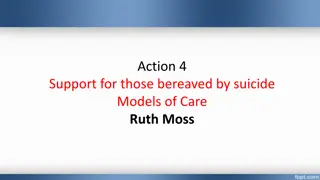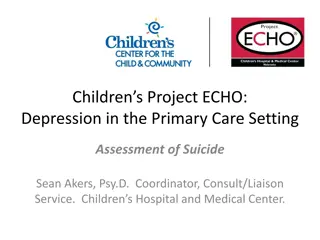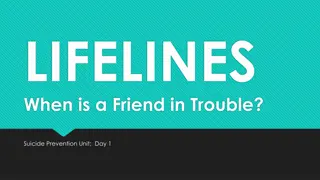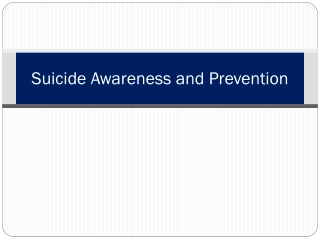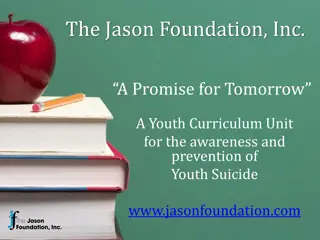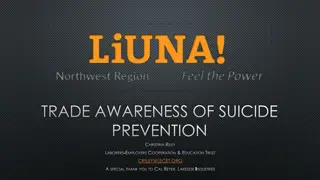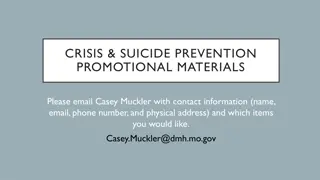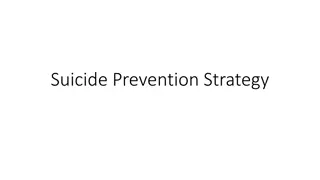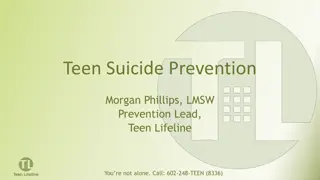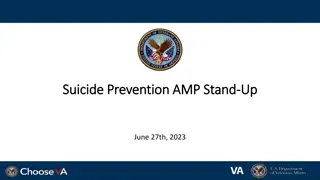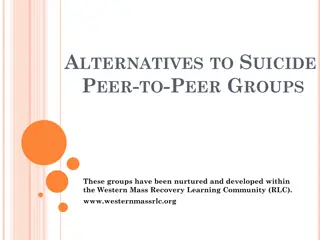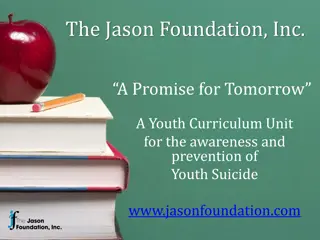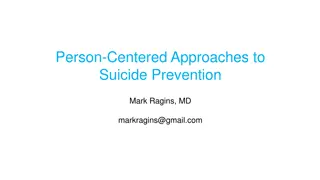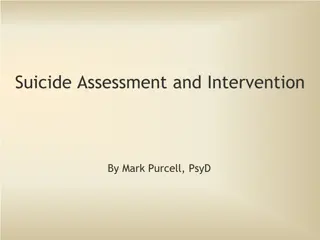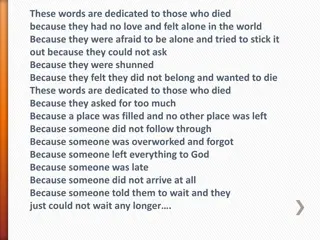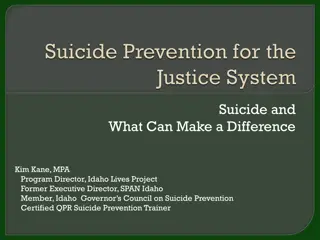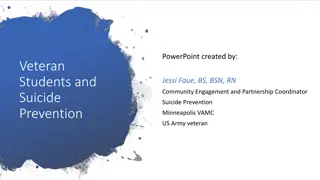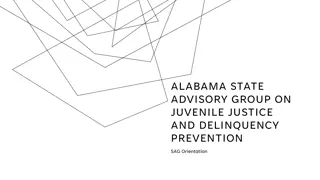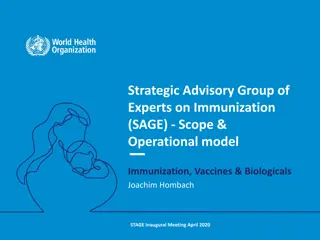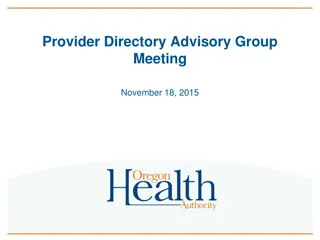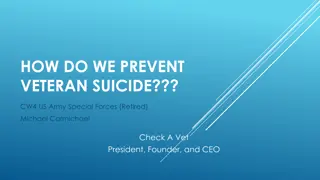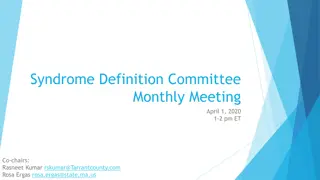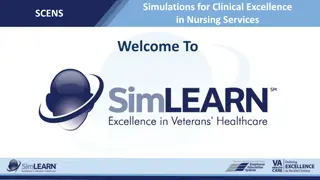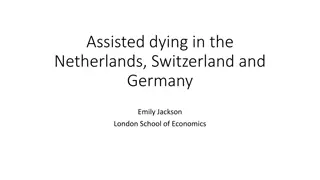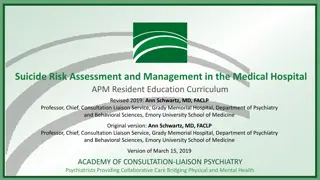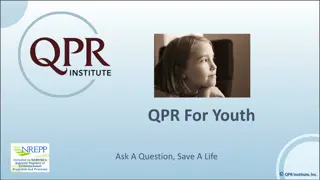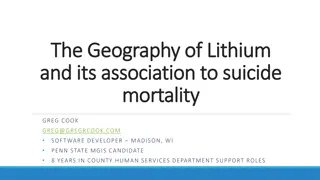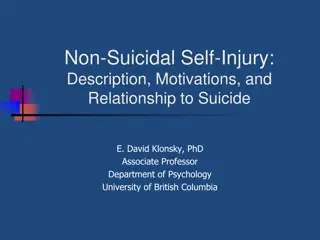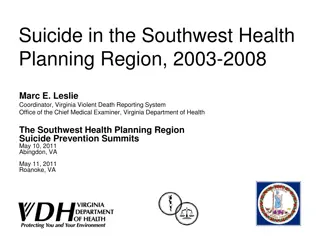Suicide Prevention Advisory Group Monthly Meeting Summary
The Suicide Prevention Advisory Group held their monthly meeting discussing collaboration with SMEs, funding priorities, consensus panel timeframe, portfolio reorganization in ISRM, AMP development, survey data review, and priority setting process. They also reviewed initial results from the SP Priority Survey and outlined next steps in priority development. The meeting included discussions on the reorganization and development of a Suicide Prevention AMP, portfolio progress based on workplan, executive committee updates, and changes in offering specific RFAs to address current challenges.
Download Presentation

Please find below an Image/Link to download the presentation.
The content on the website is provided AS IS for your information and personal use only. It may not be sold, licensed, or shared on other websites without obtaining consent from the author. Download presentation by click this link. If you encounter any issues during the download, it is possible that the publisher has removed the file from their server.
E N D
Presentation Transcript
Suicide Prevention: Advisory Group Suicide Prevention: Advisory Group Monthly Meeting Monthly Meeting February 27, 2024 Joe Constans
Agenda Agenda Time Item Objective How to collaborate with SMEs How to balance our funding priorities Timeframe for consensus panel Discuss portfolio reorganization in ISRM Review portfolio purview statement Review priority setting process 3:00 3:05 Review AMP Development Review survey data from SPRINT investigators Discuss themes of results 3:05 3:35 Initial Results from SP Priority Survey 3:35 3:45 Discussion Questions Review next steps in priority development 3:45 3:50 Next Steps
ORD Reorganization and Development of a Suicide Prevention AMP 3
Portfolio Stand Portfolio Stand- -up Progress up Progress Based on the Suicide Prevention workplan, the team plans to complete the designated documents by the end of these months. November May 2024 May - June 2024 Completed In Progress Future Items Role Charter Unit Charter Executive Committee Charter* Purview Statement* Portfolio Analysis Report* Portfolio Analysis PPT* Position Description* Portfolio Performance Metrics Critical Research Priorities Program Announcements Funding Model SOP * currently under ISRM consideration following minor edits
Executive Committee Charter Executive Committee Charter - - Updates Updates Executive Steering Committee Charter Issues Concerns that investigators have advanced knowledge of issues discussed by committee. Addressed through conflict of interest policy Minutes published within week of meeting Meeting discussion will be broadcast via TEAMS or WEBEX Conflicted members will not be present for voting (closed session no identification of individual voting and no broadcast) Proposed members who are not Federal Employees If the committee includes non-federal members, then committee needs to be established as a subcommittee of an existing FACA committee Addressed through eliminating the one (proposed) non-federal employee.
Changes in approach to offering specific RFAs Changes in approach to offering specific RFAs - - The Problem The Problem # Current Issue Details/Examples Challenges Caused BLRD: 24 CSRD: 18 HSRD: 11 RRD: 12 Additional portfolios with their own RFAs could increase the volume further. 1 Large Volume in Service RFAs Investigators will have difficulty in navigating different processes per portfolio, which will reduce collaboration. Budget caps and requirements vary across the Services Some Services use LOIs, some use pre-applications, but there is no requirement across ORD for these steps Wide variation in application requirements 2 All four Services have RFAs for Gulf War, CDA-2, RCS and DEI Three Services have RFAs for Suicide prevention, HBCU CDAs Two Services have RFAs for drug/biologics and device development ISRM will have to navigate duplicative legacy projects, which can lead to inefficiencies when new projects are funded. 3 Duplicative offerings 6
Changes in approach to offering specific RFAs Changes in approach to offering specific RFAs - - Solutions Solutions In order to address the issues we have seen in the current process and the challenges they cause for ORD, we are proposing 5 solutions that will eliminate these challenges. ORD-Wide RFAs Program Announcements RFA Standardization Pre-Applications Limited Portfolio RFAs
Changes in approach to offering specific RFAs Changes in approach to offering specific RFAs - - Solutions Solutions Program Announcements: Provide clarity to investigators on how the VA will be reviewing and funding research. Details Challenge Solved Investigators will have less difficulty navigating different processes per Portfolio, which will increase collaboration. All Portfolios will create Program Announcements These will now serve the purpose of indicating the focus area ORD is interested in funding By utilizing a combination of standardized ORD-Wide RFAs that are organized by research types with Program Announcements, ORD can increase efficiency while meeting VA research goals Timeline Implications: Each Portfolio will need to develop Program Announcements via Notices of Special Interest (NOSI) by July 1, 2024. In July, ISRM will be posting the new ORD-Wide RFAs and each Portfolio s NOSI s to help inform investigators on overall VA research focus 8
Last Meeting Recall: Rapid (and Rigorous) Approach to Identifying AMP Research Priorities Last Meeting Recall: Rapid (and Rigorous) Approach to Identifying AMP Research Priorities Survey and focus group input inform Delphi consensus panel discussion with representatives from different groups Phase II: Refine Priorities using concurrent processes: national surveys/live voting & focus groups with Consumer, Provider, Leader, Investigator groups Existing reviews inform focus group, survey questions Phase I: Identify research gaps and unanswered questions (e.g., SPM review, evidence inventories or reviews, VA program office strategic plans) Phase III: Delphi consensus panel with interested party representatives rank priorities on urgency, impact, feasibility, identify impact metrics Current Phase AMP Priorities for RFA General principles: 1. Priorities should reflect the research translation spectrum (e.g., T1-T4) 2. In-depth feedback from focus groups to identify topics not previously listed 3. Broad representation across interested parties via surveys, voting on top priorities 4. Perspectives from the front line References: 1. Aligning quality improvement efforts and policy goals in a national integrated health system - Braganza - 2022 - Health Services Research - Wiley Online Library; 2. Health System Research Priorities for Children and Youth With Special Health Care Needs - PubMed (nih.gov), 3. Research Lifecycle to Increase the Substantial Real-world Im... : Medical Care (lww.com) Measures of Impact Exec. Committee
Suicide Prevention Survey Results - SPRINT Investigators 10
Survey Survey Preview
Survey Survey - - Preview Preview 12
Survey Survey - - Preview Preview 13
Survey Survey - - Preview Preview 14
Suicide Prevention Priority Survey Suicide Prevention Priority Survey Distribution Group Survey Response Timeline Reviewing this dataset (n = 68) SPRINT Investigators 2/14 2/23 VEC Veterans 2/21 - Current CMHOs TBD Questions 1. General Identity Identity Select all that apply Percentage 2. Research Priority Domain Rating Investigator 91% 3. High Priority Domain Ranking Veteran 1% Administrator 9% 4. High Priority Domain Example Studies Clinician 35% 5. Veteran Groups to Emphasize in Funding Announcements 15
Research Priority Domain Rating Research Priority Domain Rating Ranking is based the domains averaged priority score. Rank Research Priority Domains Average 1 Lethal Means Safety approaches to suicide prevention 4.3 The rating scale ranged from 1 (low priority domain) to 5 (high priority domain). 2 Community-based interventions for suicide prevention 4.24 3 Psychotherapies and other non-somatic interventions for suicide prevention 4.18 4 Family and social network-based interventions and postventions 4.07 5 Suicide risk screening, evaluation effectiveness, and processes within VA 3.79 6 Technology, including wearable devices and text data, to assess for suicide... 3.51 7 Educational or messaging offerings to stakeholders (Veterans, community, cl... 3.38 8 Machine-based suicide risk algorithms that utilize large existing data sets... 3.31 9 Psychopharmacological and other somatic interventions (e.g., TMS) to preven... 3.19 10 Biological mechanisms and genetic contributions to suicide 2.76 16
High Priority Domain Ranking High Priority Domain Ranking Raw Data Raw Data Count of #1 Rankings Ranking based exclusively on the number of times a topic was placed at the highest level (#1 Rank) during the ranking task. Rank Research Priority Domains - Ranking 1 Psychotherapies and other non-somatic interventions for suicide prevention 13 2 Lethal Means Safety approaches to suicide prevention 7 3 Community-based interventions for suicide prevention 4 4 Family and social network-based interventions and postventions 4 5 Biological mechanisms and genetic contributions to suicide 2 Machine-based suicide risk algorithms that utilize large existing data sets to improve risk accuracy or developing precision-medicine approaches to suicide prevention 6 2 7 Suicide risk screening, evaluation effectiveness, and processes within VA 2 Educational or messaging offerings to stakeholders (Veterans, community, clinicians, families/peers, etc) 8 1 9 Psychopharmacological and other somatic interventions (e.g., TMS) to prevent suicide Technology, including wearable devices and text data, to assess for suicide risk and to provide suicide prevention interventions and self-management strategies 1 10 0 17
High Priority Domain Ranking High Priority Domain Ranking Weighted Data Weighted Data Weighted Ranking Ranking was based on weighted method: - A Ranking of 1 gives the domain a score of 10, down to a Ranking of 10 gives the domain a score of 1. Combining all rankings across all responses results in these overall ranks. Rank Research Priority Domains - Ranking 1 Community-based interventions for suicide prevention 467 2 Family and social network-based interventions and postventions 374 3 Psychotherapies and other non-somatic interventions for suicide prevention 350 4 Lethal Means Safety approaches to suicide prevention 342 Technology, including wearable devices and text data, to assess for suicide risk and to provide suicide prevention interventions and self-management strategies 5 209 6 Psychopharmacological and other somatic interventions (e.g., TMS) to prevent suicide 200 Machine-based suicide risk algorithms that utilize large existing data sets to improve risk accuracy or developing precision-medicine approaches to suicide prevention 7 145 8 Suicide risk screening, evaluation effectiveness, and processes within VA 138 9 Biological mechanisms and genetic contributions to suicide Educational or messaging offerings to stakeholders (Veterans, community, clinicians, families/peers, etc) 72 10 57 18
High Priority Domain Example Studies High Priority Domain Example Studies Domains Selected Free Responses Biological mechanisms and genetic contributions to suicide Approx half of a person's total risk for suicide is genetic in nature, but the biological basis of suicide is largely unknown. This is one of the key areas that will have to be understood better if we ever want to truly get a handle on suicide prevention and treatment of high risk individuals. I think we need to study the biomarkers (e.g., DNA methylation) of changes in suicide risk as measured by validated scales such as the BSS. Suicide risk screening, evaluation effectiveness, and processes within VA Identification of veterans at low to moderate risk who should be targeted through public health approaches, particularly those outside of mental health evaluation of effectiveness of traditional screening within VA. Does filling out a CSSRS impact clinical outcomes Can risk algorithms be developed that would eliminate need for universal screening and result in screening based on fluid risk as identified through machine-based processes. Machine-based suicide risk algorithms that utilize large existing data sets... leveraging technologies and EMA data to better understand fluctuations in suicide risk and also potential points of intervention Technology, including wearable devices and text data, to assess for suicide... I agree with those who note that VA work must be paired with community interventions to help those who will never enter a VA (the majority of suicides). We know very little in this area. Developing strategies to engage non-VHA users in SP programming at VA including LMS counseling. building collaborations with community partners and leveraging community resources to create shifts/changes in suicide outcomes over the longer term Community-based interventions for suicide prevention 19
High Priority Domain Example Studies High Priority Domain Example Studies Domains Selected Free Responses Ketamine large study needs to be done. Development ant testing of psychedelics Psychopharmacological and other somatic interventions (e.g., TMS) to preven... We need more work aimed at figuring out the most cost effective approaches for reducing suicide risk through therapy. It's not clear how much CBT-SP does over and above safety planning alone; group format's need to be explored as well as web-based and digital interventions. We need to try to get the interventions that are known to work to as many at risk veterans as possible. Developing novel psychotherapies to address suicide risk and conducting randomized controlled trials to build their evidence base Developing a large network of sites for large multi-site clinical trials. Psychotherapies and other non-somatic interventions for suicide prevention Focus resources on rapidly implementing and assessing the impact of current best practice lethal means safety for suicide prevention. Examining the impact of Lethal Means Safety Counseling Interventions on Behavior (e.g., use of safe storage); examining the impact of LMS programs and distribution of safe storage on suicidal behaviors and death Lethal Means Safety approaches to suicide prevention Interventions to improve support and helpfulness of family members and professional caregivers in their efforts to support a Veteran at risk for suicide Family and social network-based interventions and postventions Increase messaging to destigmatize suicide and increase help seeking, as well as increased messaging on resources and support options As messaging is a universal prevention strategy, having more effective messaging especially for those who are currently at low-to-moderate acute and chronic risk to increase help-seeking may help us to reach a broader risk group. Educational or messaging offerings to stakeholders (Veterans, community, cl... 20
Veteran Groups to Emphasize in Funding Announcements Veteran Groups to Emphasize in Funding Announcements Weighted Ranking Observation and recommendation: Rank Research Priority Domains - Ranking 1 Veterans outside of VHA 2.76 2 LGBTQ+ 2.73 Minimal variance between subgroups Recommend NOT using this information in any initial funding announcement Identification of certain subpopulations might best be realized through other means (e.g., Annual Report) 3 Female Veterans 2.65 4 All Veterans at Risk 2.6 5 Racial/Ethnic Minority 2.59 6 Younger Veterans 2.54 7 Justice-Involved 2.46 8 Older Veterans 2.44 21
Discussion 22
Next Steps and Next Steps and Discussion Discussion Questions Questions 1. Complete collection of survey response a. VEC 2/29/2024 b. SPC VISN Leads / CHMOs March 8th c. Front line clinicians - ? 2. Synthesize Data / Determine topics for SME input a. Working subgroup Dobscha, Strickland, Constans (?) 23
Next Steps and Next Steps and Discussion Discussion Questions Questions 3. Identify Research Gaps for NOSI a. SOTA versus solicit feedback from multiple SME Benefits of Solicit multiple SMEs Broader range of feedback Avoid COI related to SME study area Logistical benefits 4. Hold Executive Session to vote on priorities May 28 5. NOSI (internal to ORD) Publish July 1 Determine $ amount 24
Next Steps and Discussion Questions Next Steps and Discussion Questions How to collaborate with SMEs Selecting SMEs based on top priorities SMEs vs SME groups Seeking gaps in topics How to balance our funding priorities Development of Notices of Special Interest Timeframe for consensus panel May 2024? 25
Next Steps 26
Next Steps Next Steps Collection and Analysis of Data from remaining Survey groups Selection of SMEs for Panel Discussion Determination of Questions for each Topic Area Scheduling Consensus Panel Meeting 27
Appendix 28
Critical Research Priority Setting Critical Research Priority Setting Evaluation of Priorities Evaluation of Priorities Defense Health Agency (DHA) Evaluation of Priorities DHA 2020 Prioritized Research Gaps Report for Suicide Prevention Topics The 2020 Research Gaps Report: Suicide Prevention Research Priorities | Health.mil Process Gather all 186 priorities across all 26 sources and create keyword categories based on the priority language. With the resulting keyword categories, priority statements were drafted to summarize the priorities in that group (on the following slide) Screening, Evaluation, Risk Determination, and Referral to Treatment Lethal means safety interventions. Risk and Protective Factors Crisis response plans/safety planning Implementation of cognitive-behavioral therapy for suicidal ideation. Non-pharmacologic Interventions Decision Rule 5 or more occurrences of a keyword within the priorities results in a new category Technology-based interventions and adjuncts for treatment. Pharmacologic Interventions Example Risk occurred 15 times across the priorities, including the ones highlighted in the source to the left. Dialectical behavior therapy (DBT) for suicidal ideation Community-based Interventions Post-acute Care Approaches Caring contact 29
Priority Questionnaire Priority Questionnaire Summary Statistics Summary Statistics Summary Statistics Evaluation of Priorities Count 54 Process Review Priorities #1 - #5 for all records and code into a cell of the priority matrix. In order to apply a weight to the #1 through #5 priorities, #1 was given a weight of 5, #2 was given a weight of 4, and so on. Mean 6.4 Median 4 Decision Rule Each response was coded based on the destination cell of the category and the population grouping. Any responses that was not specific to a category or populations was designated into a cross-cutting group. If there was a specific reference to multiple categories or populations, the priority was coded into both. Example Improve understanding of female veteran suicide risk; test interventions and upstream opportunities to reduce risk (e.g., preventing/treating MH, SU, IPV) was coded with F12 [Female Veterans, Cross-Cutting] H12 [Social Determinants of Health, Cross-Cutting]. As this was a Priority #2, it was given a weight of 4 in each F12 and H12 in the final Priority Matrix calculations. 30
For consideration by the group For consideration by the group Suggestions regarding weighting of quantitative and qualitative data to identify content domains for consideration? Thoughts on ranking or rating of content domains in the survey? That is, what do you see as the benefits of ranking over rating and visa versa? How many domains should be considered on the survey? What are the recommendations regarding specificity in the domains in survey? For example, if Lethal Means Safety Should we leave it at the content domain (Lethal Means Safety) Or should we present different options regarding intersection between population and methods (i.e., LMS in primary care; LMS in community) 31
Phase 1: Critical Research Priority Setting for Suicide Prevention Phase 1: Critical Research Priority Setting for Suicide Prevention American Foundation for Suicide Prevention Utilizing these sources as a base, the team gathered priorities from a total of 26 sources, resulting in 186 cumulative priorities American Psychological Association CDC Defense Health Agency (DHA) Department of Defense Indian Health Service National Action Alliance for Suicide Prevention (NAASP) NAMI These priorities were coded into research categories to reflect method/procedure and characteristic of prioritized population. NIMH SAMSHA VHA White House Peer-reviewed Research 32
Phase 1: Developing the Priority Matrix Phase 1: Developing the Priority Matrix Younger Veterans (22- 34) Older Veterans Female Veterans Race/Ethnicit y Substance Abuse Medical Disease Justice Involvement Trauma/ Moral InjuryMental Health Cross- Cutting Firearms SDOH TBI LGBTQ Category Biology/ Genomics/Brain Risk Factor Assessment/ Screening - clinician/questionnaire Risk Factor Assessment - machine learning Continuous monitoring Family /Social Network Pharmacotherapy and other Somatic Interventions Psychotherapy and other Non-Somatic Interventions Community Interventions Education, Training, & Messaging Precision Medicine ? Cross-Cutting Postvention First Column Categories reflect Method or Procedure. First Row Categories reflect Risk Factors A priority could be placed into a cell reflecting risk factor and method.
Phase 2: Gathering input from various stakeholders Phase 2: Gathering input from various stakeholders Priority Questionnaire Distribution to Field A survey was sent out to investigators within the SPRINT database. We collected responses from 54 respondents, each listing ranked research priorities. These priorities were coded into the categories developed in Phase 1. Veteran s Engagement Council Discussion Our team met with a Veteran s Engagement Council in December to hold a discussion and gather research topics of interest to veterans. The topics covered in the discussion were also coded into the categories developed in Phase 1. VISN Suicide Prevention Lead Open Discussion Today, we are hoping to review progress on suicide prevention research priorities and gather your input and feedback as we continue to refine the priorities.
Phase 2: Priority Questionnaire Distribution to Field Phase 2: Priority Questionnaire Distribution to Field Greetings VA Suicide Prevention investigators, Beginning October 1, 2024, suicide prevention research will be housed within the Suicide Prevention Actively Managed Portfolio (SP AMP). The SP AMP team is currently working with an Executive Steering Committee to establish governance policy and processes for the SP AMP and to establish initial priority areas for VA suicide prevention research. The priority setting efforts will follow a strategy developed by QUERI which seeks input from multiple stakeholders throughout the priority setting process. As part of our initial efforts, we are asking for your assistance in identifying topic areas that you believe are important to advance suicide prevention efforts in VA. To help us gather a thorough body of topic areas, we ask that you identify up to 10 research areas for which there are significant gaps in extant knowledge and for which research support is needed. If you are willing to assist us in these initial efforts to identify possible priority areas, please click on this link which will provide further instruction. Please provide feedback as soon as possible but no later than November 17th. Thanks in advance for your willingness to help. We will be providing more information to the field as this process advances.
Phase 2: Populating the Priority Matrix Phase 2: Populating the Priority Matrix Initial Categorization of Priorities Identified by Survey Respondents Younger Veterans (22- 34) Female Veterans Substance Abuse Justice Involvement Trauma/ Moral Injury Category Cross-Cutting Firearms Older Veterans Race/Ethnicity SDOH Medical Disease TBI LGBTQ Mental Health SUM Biology/ Genomics/Brain 45 0 0 0 0 0 0 0 0 0 0 0 0 0 45 Risk Factor Assessment/ Screening - clinician/questionnaire 25 0 5 5 0 0 8 0 10 0 0 0 0 3 56 Risk Factor Assessment - machine learning 22 0 0 0 0 0 0 0 0 0 0 0 0 0 22 Continuous monitoring 13 0 0 0 0 0 0 0 0 0 0 0 0 0 13 Family /Social Network 13 6 0 0 0 0 0 0 0 0 0 0 0 0 19 Pharmacotherapy and other Somatic Interventions 29 0 0 0 0 0 0 0 0 0 0 0 0 1 30 Psychotherapy and other Non-Somatic Interventions 42 25 0 0 0 0 22 0 0 0 0 5 5 1 100 Community Interventions 56 7 0 5 0 0 0 0 0 0 0 0 0 0 68 Education, Training, & Messaging 17 10 0 0 0 0 0 0 0 0 0 0 0 0 27 Precision Medicine ? Cross-Cutting 6 5 0 0 0 3 0 0 0 0 2 0 4 0 4 0 5 0 0 6 0 6 49 34 25 16 32 31 18 Postvention 16 0 0 0 0 0 0 0 0 0 0 0 0 0 16 SUM 97 39 13 25 16 62 2 14 4 5 36 11 23
Phase 2: Potential Priorities as identified through Matrix coding Phase 2: Potential Priorities as identified through Matrix coding Category Example Responses to Unstructured Survey Psychotherapy and other Non- Somatic Interventions Multi-site RTC to determine interventions most likely to prevention suicide death. Firearms, Lethal Means Safety Does LMS counseling in primary care settings reduce suicide deaths? Community Interventions What community interventions effectively promote safe storage? Social Determinants of Health Do programs that address SDOH (i.e., providing housing to unhoused Veterans) decrease suicide for those at risk? Risk Factor Assessment Screening How can algorithms be improved to include dynamic risk factors of suicide? Biology, Genomics, Brain Neuroimaging (fMRI, DTI, MRS) studies of suicide: emphasis on measures of impulsivity, negative affect processing, reward, decision making. Older Veterans Developing age-specific interventions for older Veterans. LGBTQ+ Interventions for sexual minority / LGBQ veterans. 37
Phase 2: Veterans Engagement Council Discussion Phase 2: Veteran s Engagement Council Discussion Key Questions for Audience: Research Priorities Discussed during Meeting Hard to Reach Veterans (Isolating Veterans/ Veterans not in VA care/ Rural Veterans / Transitioning to civilian) Continuity of Care* Community Research (including family) Developing Novel Treatments (including provider perspective) Moral Injury/Spiritual Lethal Means Safety Messaging Peer Support Messaging Data Studies Racial/Ethnic/Sexual Minorities Brain/TBI/Genomics (low priority) 1. What suicide prevention research topics come to mind as most important for Veterans from your perspective? 2. Are there specific patient populations it would be important to study (if this has not come up)? 3. Are there any research topics you don t think are as high a priority? 4. Are there particular topics within this area that come to mind that would be important for VA researchers to work on? 38 * - category not identified through investigator survey
Phase 2: VISN Suicide Prevention Lead Phase 2: VISN Suicide Prevention Lead Open Discussion Open Discussion Key Questions for Audience: Research Priorities Discussed during Meeting Risk Identification Process* Needs modification Clinician burden too high Clinical Trial Feasibility* Psychotherapy Small trials will not advance practice Community Interventions Education, Training, and Messaging Firearms, Lethal Means Safety Safety Planning Older Veterans Female Veterans 1. What areas in suicide prevention do you think needs more research to support your clinical decision-making? 2. How does your program implement current research evidence or data regarding assessing suicide risk? What would make risk assessment processes or resulting risk information more useful or actionable? 3. How do you use the information you have now regarding effectiveness of suicide prevention interventions and treatments? What new information would help your program make evidence-informed treatment planning decisions? 4. Are there certain patient characteristics that are important to study or to include in VA research? * - similar category / different perspective 39
